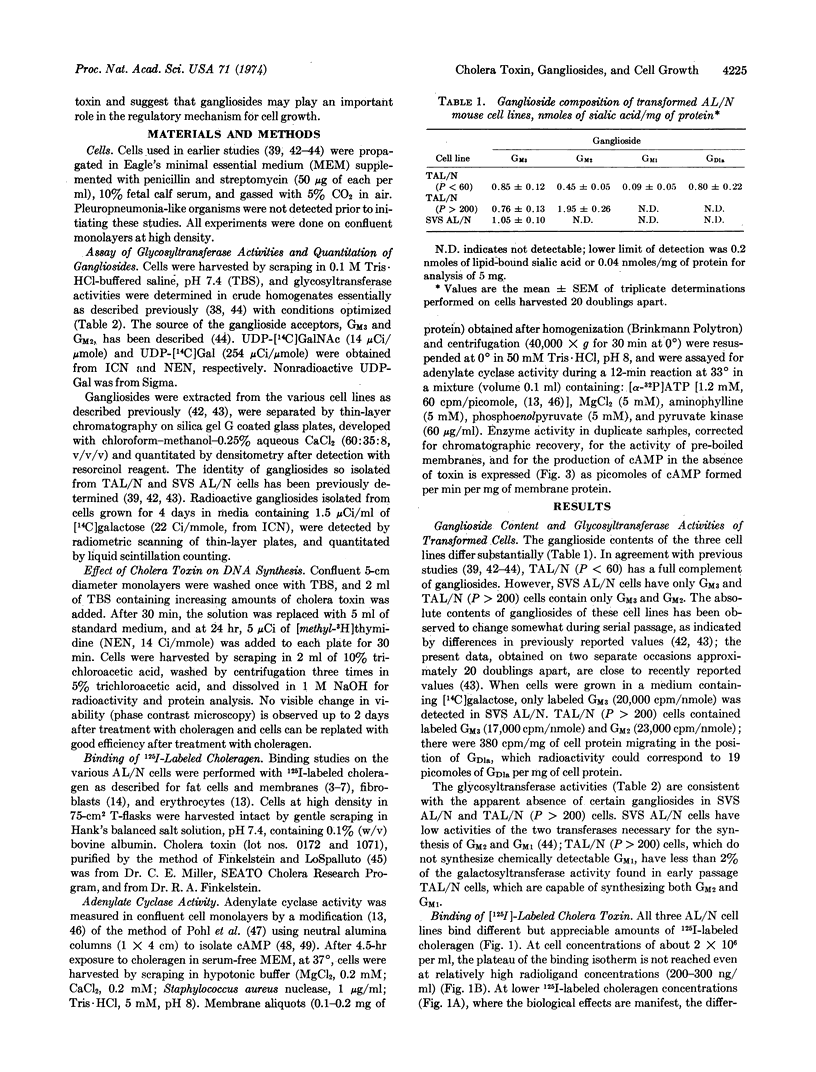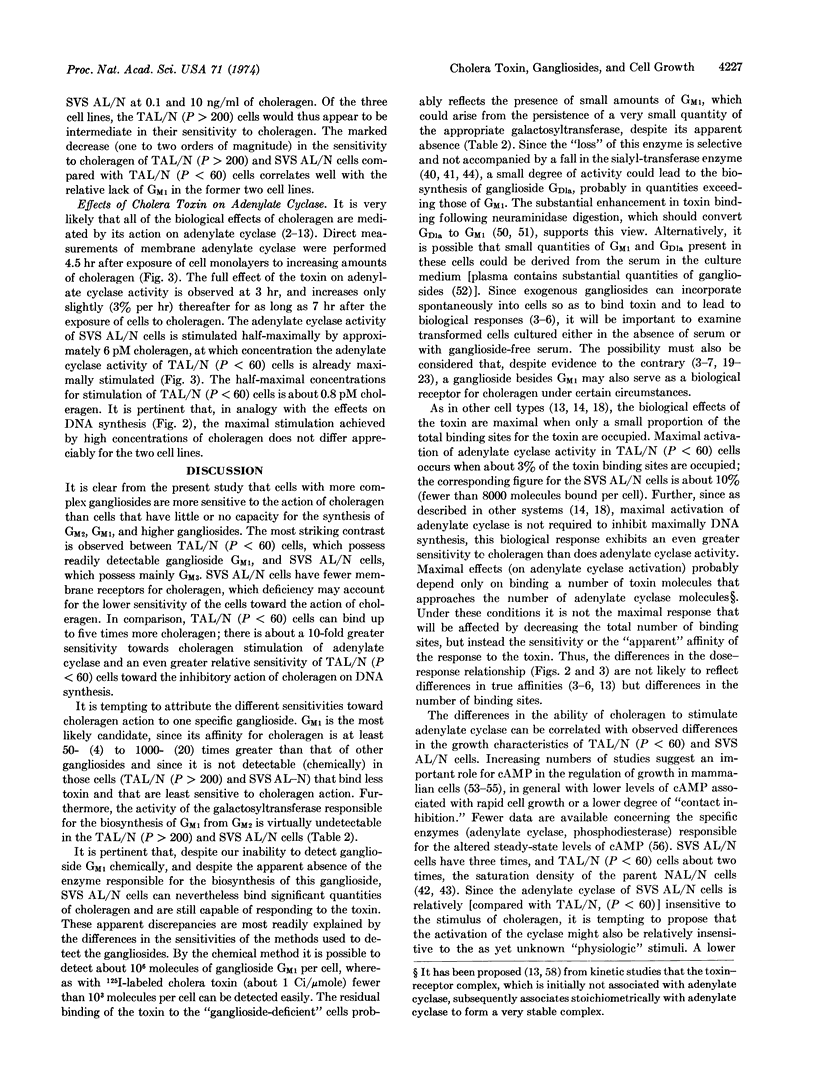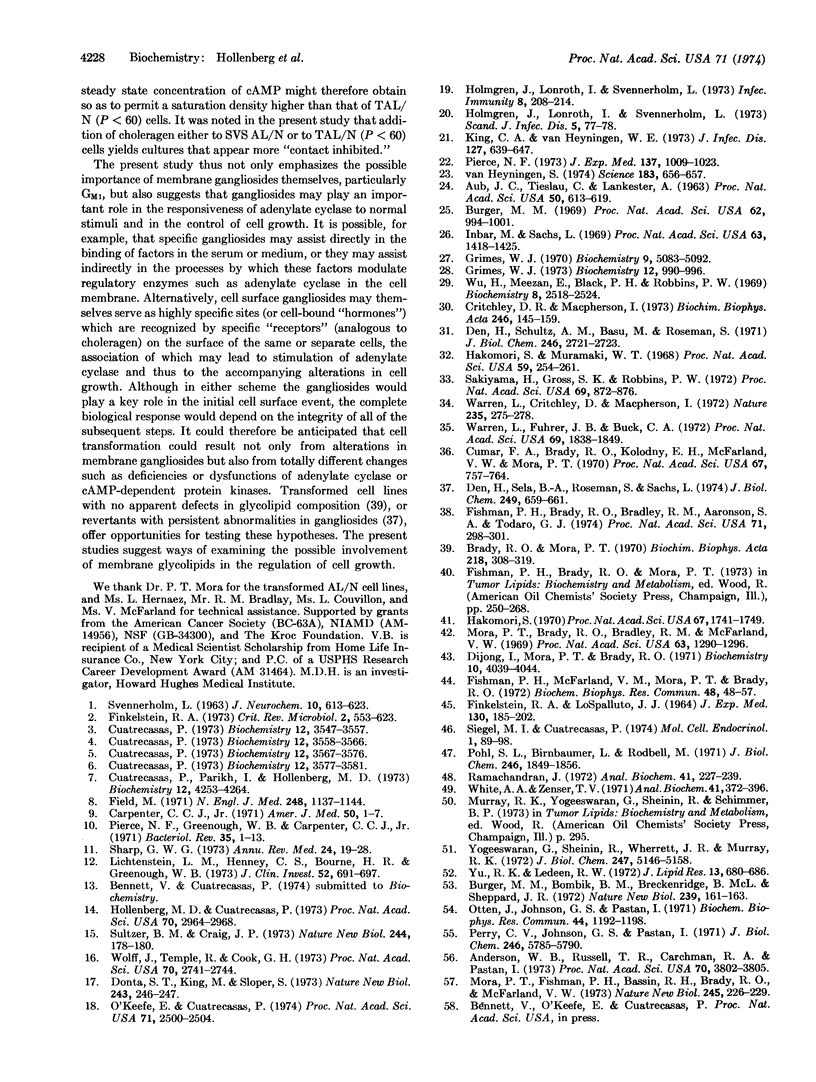Abstract
The binding of cholera toxin to three transformed mouse cell lines derived from the same parent strain, and the effects of the toxin on DNA synthesis and adenylate cyclase activity, vary in parallel with the ganglioside composition of the cells. TAL/N cells of early passage, which contain large quantities of gangliosides GM3, GM2, GM1, and GDla, as well as the glycosyltransferases necessary for the synthesis of these gangliosides, bind the most cholera toxin and are the most sensitive to its action. TAL/N cells of later passage, which lack chemically detectable GM1 and GDla and which have no UDP-Gal:GM2 galactosyltransferase activity, are intermediate in binding and response to the toxin. SVS AL/N cells, which lack GM2 in addition to GM1 and GDla and which have little detectable UDP-GalNAc:GM3N-acetylgalactosaminyltransferase activity, bind the least amount of toxin. The SVS AL/N cells are the least responsive to inhibition of DNA synthesis and stimulation of adenylate cyclase activity by cholera toxin. Gangliosides (especially GM1), which appear to be the natural membrane receptors for cholera toxin, may normally have important roles in the regulation of cell growth and cAMP-mediated responses.
Keywords: adenylate cyclase, cAMP, glycosyltransferases, DNA synthesis
Full text
PDF




Selected References
These references are in PubMed. This may not be the complete list of references from this article.
- AUB J. C., TIESLAU C., LANKESTER A. REACTIONS OF NORMAL AND TUMOR CELL SURFACES TO ENZYMES. I. WHEAT-GERM LIPASE AND ASSOCIATED MUCOPOLYSACCHARIDES. Proc Natl Acad Sci U S A. 1963 Oct;50:613–619. doi: 10.1073/pnas.50.4.613. [DOI] [PMC free article] [PubMed] [Google Scholar]
- Anderson W. B., Russell T. R., Carchman R. A., Pastan I. Interrelationship between adenylate cyclase activity, adenosine 3':5' cyclic monophosphate phosphodiesterase activity, adenosine 3':5' cyclic monophosphate levels, and growth of cells in culture. Proc Natl Acad Sci U S A. 1973 Dec;70(12):3802–3805. doi: 10.1073/pnas.70.12.3802. [DOI] [PMC free article] [PubMed] [Google Scholar]
- Burger M. M. A difference in the architecture of the surface membrane of normal and virally transformed cells. Proc Natl Acad Sci U S A. 1969 Mar;62(3):994–1001. doi: 10.1073/pnas.62.3.994. [DOI] [PMC free article] [PubMed] [Google Scholar]
- Burger M. M., Bombik B. M., Breckenridge B. M., Sheppard J. R. Growth control and cyclic alterations of cyclic AMP in the cell cycle. Nat New Biol. 1972 Oct 11;239(93):161–163. doi: 10.1038/newbio239161a0. [DOI] [PubMed] [Google Scholar]
- Carpenter C. C., Jr Cholera enterotoxin--recent investigations yield insights into transport processes. Am J Med. 1971 Jan;50(1):1–7. doi: 10.1016/0002-9343(71)90198-7. [DOI] [PubMed] [Google Scholar]
- Critchley D. R., Macpherson I. Cell density dependent glycolipids in NILz hamster cells, derived malignant and transformed cell lines. Biochim Biophys Acta. 1973 Jan 19;296(1):145–159. doi: 10.1016/0005-2760(73)90054-4. [DOI] [PubMed] [Google Scholar]
- Cuatrecasas P. Cholera toxin-fat cell interaction and the mechanism of activation of the lipolytic response. Biochemistry. 1973 Aug 28;12(18):3567–3577. doi: 10.1021/bi00742a033. [DOI] [PubMed] [Google Scholar]
- Cuatrecasas P. Gangliosides and membrane receptors for cholera toxin. Biochemistry. 1973 Aug 28;12(18):3558–3566. doi: 10.1021/bi00742a032. [DOI] [PubMed] [Google Scholar]
- Cuatrecasas P. Interaction of Vibrio cholerae enterotoxin with cell membranes. Biochemistry. 1973 Aug 28;12(18):3547–3558. doi: 10.1021/bi00742a031. [DOI] [PubMed] [Google Scholar]
- Cuatrecasas P., Parikh I., Hollenberg M. D. Affinity chromatography and structural analysis of Vibrio cholerae enterotoxin-ganglioside agarose and the biological effects of ganglioside-containing soluble polymers. Biochemistry. 1973 Oct 9;12(21):4253–4264. doi: 10.1021/bi00745a033. [DOI] [PubMed] [Google Scholar]
- Cuatrecasas P. Vibrio cholerae choleragenoid. Mechanism of inhibition of cholera toxin action. Biochemistry. 1973 Aug 28;12(18):3577–3581. doi: 10.1021/bi00742a034. [DOI] [PubMed] [Google Scholar]
- Cumar F. A., Brady R. O., Kolodny E. H., McFarland V. W., Mora P. T. Enzymatic block in the synthesis of gangliosides in DNA virus-transformed tumorigenic mouse cell lines. Proc Natl Acad Sci U S A. 1970 Oct;67(2):757–764. doi: 10.1073/pnas.67.2.757. [DOI] [PMC free article] [PubMed] [Google Scholar]
- Den H., Schultz A. M., Basu M., Roseman S. Glycosyltransferase activities in normal and polyoma-transformed BHK cells. J Biol Chem. 1971 Apr 25;246(8):2721–2723. [PubMed] [Google Scholar]
- Den H., Sela B. A., Roseman S., Sachs L. Blocks in ganglioside synthesis in transformed hamster cells and their revertants. J Biol Chem. 1974 Jan 25;249(2):659–661. [PubMed] [Google Scholar]
- Dijong I., Mora P. T., Brady R. O. Gas chromatographic determination of gangliosides in mouse cell lines and in virally transformed derivative lines. Biochemistry. 1971 Oct 26;10(22):4039–4044. doi: 10.1021/bi00798a005. [DOI] [PubMed] [Google Scholar]
- Donta S. T., King M., Sloper K. Induction of steroidogenesis in tissue culture by cholera enterotoxin. Nat New Biol. 1973 Jun 20;243(129):246–247. doi: 10.1038/newbio243246a0. [DOI] [PubMed] [Google Scholar]
- Finkelstein R. A., LoSpalluto J. J. Pathogenesis of experimental cholera. Preparation and isolation of choleragen and choleragenoid. J Exp Med. 1969 Jul 1;130(1):185–202. doi: 10.1084/jem.130.1.185. [DOI] [PMC free article] [PubMed] [Google Scholar]
- Fishman P. H., Brady R. O., Bradley R. M., Aaronson S. A., Todaro G. J. Absence of a specific ganglioside galactosyltransferase in mouse cells transformed by murine sarcoma virus. Proc Natl Acad Sci U S A. 1974 Feb;71(2):298–301. doi: 10.1073/pnas.71.2.298. [DOI] [PMC free article] [PubMed] [Google Scholar]
- Fishman P. H., McFarland V. W., Mora P. T., Brady R. O. Ganglioside biosynthesis in mouse cells: glycosyltransferase activities in normal and virally-transformed lines. Biochem Biophys Res Commun. 1972 Jul 11;48(1):48–57. doi: 10.1016/0006-291x(72)90342-7. [DOI] [PubMed] [Google Scholar]
- Grimes W. J. Glycosyltransferase and sialic acid levels of normal and transformed cells. Biochemistry. 1973 Feb 27;12(5):990–996. doi: 10.1021/bi00729a031. [DOI] [PubMed] [Google Scholar]
- Grimes W. J. Sialic acid transferases and sialic acid levels in normal and transformed cells. Biochemistry. 1970 Dec 22;9(26):5083–5092. doi: 10.1021/bi00828a007. [DOI] [PubMed] [Google Scholar]
- Hakomori S. I., Murakami W. T. Glycolipids of hamster fibroblasts and derived malignant-transformed cell lines. Proc Natl Acad Sci U S A. 1968 Jan;59(1):254–261. doi: 10.1073/pnas.59.1.254. [DOI] [PMC free article] [PubMed] [Google Scholar]
- Hakomori S. Cell density-dependent changes of glycolipid concentrations in fibroblasts, and loss of this response in virus-transformed cells. Proc Natl Acad Sci U S A. 1970 Dec;67(4):1741–1747. doi: 10.1073/pnas.67.4.1741. [DOI] [PMC free article] [PubMed] [Google Scholar]
- Heyningen S Van Cholera toxin: interaction of subunits with ganglioside GM1. Science. 1974 Feb 15;183(4125):656–657. doi: 10.1126/science.183.4125.656. [DOI] [PubMed] [Google Scholar]
- Hollenberg M. D., Cuatrecasas P. Epidermal growth factor: receptors in human fibroblasts and modulation of action by cholera toxin. Proc Natl Acad Sci U S A. 1973 Oct;70(10):2964–2968. doi: 10.1073/pnas.70.10.2964. [DOI] [PMC free article] [PubMed] [Google Scholar]
- Holmgren J., Lönnroth I., Svennerholm L. Fixation and inactivation of cholera toxin by GM1 ganglioside. Scand J Infect Dis. 1973;5(1):77–78. doi: 10.3109/inf.1973.5.issue-1.15. [DOI] [PubMed] [Google Scholar]
- Holmgren J., Lönnroth I., Svennerholm L. Tissue receptor for cholera exotoxin: postulated structure from studies with GM1 ganglioside and related glycolipids. Infect Immun. 1973 Aug;8(2):208–214. doi: 10.1128/iai.8.2.208-214.1973. [DOI] [PMC free article] [PubMed] [Google Scholar]
- Inbar M., Sachs L. Interaction of the carbohydrate-binding protein concanavalin A with normal and transformed cells. Proc Natl Acad Sci U S A. 1969 Aug;63(4):1418–1425. doi: 10.1073/pnas.63.4.1418. [DOI] [PMC free article] [PubMed] [Google Scholar]
- King C. A., Van Heyningen W. E. Deactivation of cholera toxin by a sialidase-resistant monosialosylganglioside. J Infect Dis. 1973 Jun;127(6):639–647. doi: 10.1093/infdis/127.6.639. [DOI] [PubMed] [Google Scholar]
- Lichtenstein L. M., Henney C. S., Bourne H. R., Greenough W. B., 3rd Effects of cholera toxin on in vitro models of immediate and delayed hypersensitivity. Further evidence for the role of cyclic adenosine 3',5'-monophosphate. J Clin Invest. 1973 Mar;52(3):691–697. doi: 10.1172/JCI107230. [DOI] [PMC free article] [PubMed] [Google Scholar]
- Meezan E., Wu H. C., Black P. H., Robbins P. W. Comparative studies on the carbohydrate-containing membrane components of normal and virus-transformed mouse fibroblasts. II. Separation of glycoproteins and glycopeptides by sephadex chromatography. Biochemistry. 1969 Jun;8(6):2518–2524. doi: 10.1021/bi00834a039. [DOI] [PubMed] [Google Scholar]
- Mora P. T., Brady R. O., Bradley R. M., McFarland V. W. Gangliosides in DNA virus-transformed and spontaneously transformed tumorigenic mouse cell lines. Proc Natl Acad Sci U S A. 1969 Aug;63(4):1290–1296. doi: 10.1073/pnas.63.4.1290. [DOI] [PMC free article] [PubMed] [Google Scholar]
- Mora P. T., Fishman P. H., Bassin R. H., Brady R. O., McFarland V. W. Transformation of Swiss 3T3 cells by murine sarcoma virus is followed by decrease in a glycolipid glycosyltransferase. Nat New Biol. 1973 Oct 24;245(147):226–229. doi: 10.1038/newbio245226a0. [DOI] [PubMed] [Google Scholar]
- O'Keefe E., Cuatrecasas P. Cholera toxin mimics melanocyte stimulating hormone in inducing differentiation in melanoma cells. Proc Natl Acad Sci U S A. 1974 Jun;71(6):2500–2504. doi: 10.1073/pnas.71.6.2500. [DOI] [PMC free article] [PubMed] [Google Scholar]
- Otten J., Johnson G. S., Pastan I. Cyclic AMP levels in fibroblasts: relationship to growth rate and contact inhibition of growth. Biochem Biophys Res Commun. 1971 Sep;44(5):1192–1198. doi: 10.1016/s0006-291x(71)80212-7. [DOI] [PubMed] [Google Scholar]
- Peery C. V., Johnson G. S., Pastan I. Adenyl cyclase in normal and transformed fibroblasts in tissue culture. Activation by prostaglandins. J Biol Chem. 1971 Sep 25;246(18):5785–5790. [PubMed] [Google Scholar]
- Pierce N. F. Differential inhibitory effects of cholera toxoids and ganglioside on the enterotoxins of Vibrio cholerae and Escherichia coli. J Exp Med. 1973 Apr 1;137(4):1009–1023. doi: 10.1084/jem.137.4.1009. [DOI] [PMC free article] [PubMed] [Google Scholar]
- Pierce N. F., Greenough W. B., 3rd, Carpenter C. C., Jr Vibrio cholerae enterotoxin and its mode of action. Bacteriol Rev. 1971 Mar;35(1):1–13. doi: 10.1128/br.35.1.1-13.1971. [DOI] [PMC free article] [PubMed] [Google Scholar]
- Pohl S. L., Birnbaumer L., Rodbell M. The glucagon-sensitive adenyl cyclase system in plasma membranes of rat liver. I. Properties. J Biol Chem. 1971 Mar 25;246(6):1849–1856. [PubMed] [Google Scholar]
- SVENNERHOLM L. CHROMATOGRAPHIC SEPARATION OF HUMAN BRAIN GANGLIOSIDES. J Neurochem. 1963 Sep;10:613–623. doi: 10.1111/j.1471-4159.1963.tb08933.x. [DOI] [PubMed] [Google Scholar]
- Sakiyama H., Gross S. K., Robbins P. W. Glycolipid synthesis in normal and virus-transformed hamster cell lines. Proc Natl Acad Sci U S A. 1972 Apr;69(4):872–876. doi: 10.1073/pnas.69.4.872. [DOI] [PMC free article] [PubMed] [Google Scholar]
- Sharp G. W. Action of cholera toxin on fluid and electrolyte movement in the small intestine. Annu Rev Med. 1973;24:19–23. doi: 10.1146/annurev.me.24.020173.000315. [DOI] [PubMed] [Google Scholar]
- Siegel M. I., Cuatrecasas P. Epinephrine stimulation of fat cell adenylate cyclase: regulation by guanosine-5'-triphosphate and magnesium ion. Mol Cell Endocrinol. 1974 Apr;1(2):89–98. doi: 10.1016/0303-7207(74)90002-1. [DOI] [PubMed] [Google Scholar]
- Sultzer B. M., Craig J. P. Cholera toxin inhibits macromolecular synthesis in mouse spleen cells. Nat New Biol. 1973 Aug 8;244(136):178–180. doi: 10.1038/newbio244178a0. [DOI] [PubMed] [Google Scholar]
- Warren L., Critchley D., Macpherson I. Surface glycoproteins and glycolipids of chicken embryo cells transformed by a temperature-sensitive mutant of Rous sarcoma virus. Nature. 1972 Feb 4;235(5336):275–278. doi: 10.1038/235275a0. [DOI] [PubMed] [Google Scholar]
- Warren L., Fuhrer J. P., Buck C. A. Surface glycoproteins of normal and transformed cells: a difference determined by sialic acid and a growth-dependent sialyl transferase. Proc Natl Acad Sci U S A. 1972 Jul;69(7):1838–1842. doi: 10.1073/pnas.69.7.1838. [DOI] [PMC free article] [PubMed] [Google Scholar]
- White A. A., Zenser T. V. Separation of cyclic 3',5'-nucleoside monophosphates from other nucleotides on aluminum oxide columns. Application to the assay of adenyl cyclase and guanyl cyclase. Anal Biochem. 1971 Jun;41(2):372–396. doi: 10.1016/0003-2697(71)90156-4. [DOI] [PubMed] [Google Scholar]
- Wolff J., Temple R., Cook G. H. Stimulation of steroid secretion in adrenal tumor cells by choleragen. Proc Natl Acad Sci U S A. 1973 Oct;70(10):2741–2744. doi: 10.1073/pnas.70.10.2741. [DOI] [PMC free article] [PubMed] [Google Scholar]
- Yogeeswaran G., Sheinin R., Wherrett J. R., Murray R. K. Studies on the glycosphingolipids of normal and virally transformed 3T3 mouse fibroblasts. J Biol Chem. 1972 Aug 25;247(16):5146–5148. [PubMed] [Google Scholar]
- Yu R. K., Ledeen R. W. Gangliosides of human, bovine, and rabbit plasma. J Lipid Res. 1972 Sep;13(5):680–686. [PubMed] [Google Scholar]


